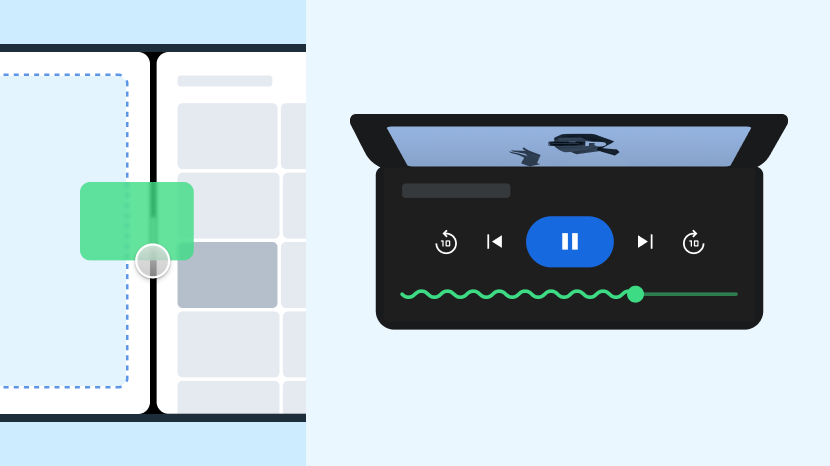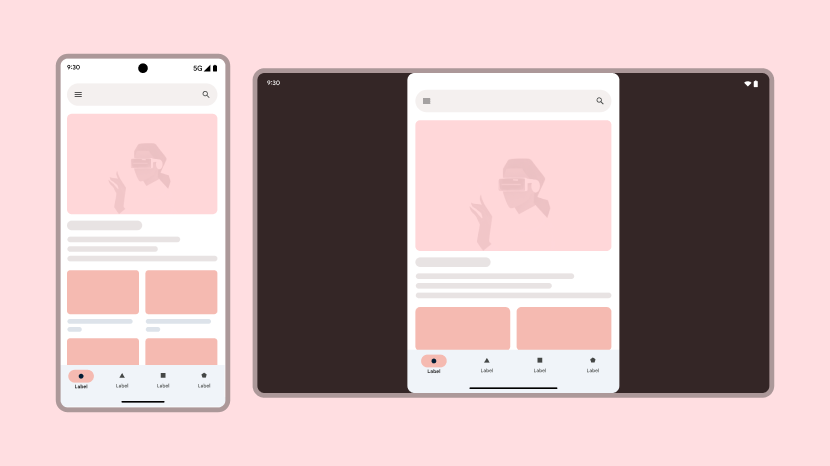![]()
ระดับ 1 — ระดับคุณภาพสูงสุดของหลักเกณฑ์คุณภาพแอปบนหน้าจอขนาดใหญ่

แอปที่แยกความแตกต่างสำหรับหน้าจอขนาดใหญ่สร้างประสบการณ์การใช้งานที่อุปกรณ์หน้าจอขนาดเล็กให้ไม่ได้
แอปที่แยกความแตกต่างสำหรับหน้าจอขนาดใหญ่ช่วยให้การทำงานหลายอย่างพร้อมกันและการลากและวางสะดวกและง่ายดาย แอปที่แตกต่างรองรับฟีเจอร์เฉพาะของอุปกรณ์แบบพับได้ เช่น การวางแนวตั้งบนโต๊ะ เพื่อให้ผู้ใช้ได้รับประสบการณ์การใช้งานที่อุปกรณ์ประเภทอื่นๆ ไม่สามารถมอบให้ได้
การรองรับแป้นพิมพ์ เมาส์ และแทร็กแพดภายนอกเทียบเท่ากับคอมพิวเตอร์เดสก์ท็อป การรองรับสไตลัสอย่างครอบคลุมทำให้สไตลัสเป็นส่วนสำคัญของอุปกรณ์
สิ่งที่ควรและไม่ควรทำ

ควรทำ
- คิดให้ใหญ่
- ออกแบบเลย์เอาต์และลักษณะการทำงานที่กำหนดเอง
- ทําให้แอปแตกต่างจากแอปอื่นๆ

ไม่ควรทำ
- ยอมรับสิ่งที่น้อยกว่า
- ออกแบบสำหรับอุปกรณ์เพียง 1 หรือ 2 ประเภท
- ให้ความสำคัญกับแอปของคุณ
หลักเกณฑ์
สร้างความโดดเด่นให้แอปโดยทำตามหลักเกณฑ์ระดับ 1
การทํางานหลายอย่างพร้อมกันและอินสแตนซ์หลายรายการ
ช่วยให้ผู้ใช้ทำงานได้มากขึ้นด้วยการทำงานหลายอย่างพร้อมกันบนหน้าจอขนาดใหญ่
อะไร
แอปรองรับโหมดการทำงานหลายอย่างพร้อมกันทั้งหมด ซึ่งรวมถึงโหมดหลายหน้าต่าง หลายอินสแตนซ์ และภาพซ้อนภาพ
ทำไมจึงควร
หน้าจอขนาดใหญ่มีพื้นที่แสดงผลมากพอให้ผู้ใช้ทำงานกับหลายแอปพร้อมกัน
อย่างไร
ดูวิธีรวมแอปไว้ในการทำงานแบบหลายงานในภาพรวมการทำงานแบบหลายงานและหลายอินสแตนซ์
ท่าทางและสถานะแบบพับได้
อุปกรณ์แบบพับได้ที่มีหน้าจอขนาดใหญ่เปรียบเสมือนโทรศัพท์และแท็บเล็ตรวมกัน ฟีเจอร์การพับ เช่น การวางบนโต๊ะและการวางแบบหนังสือ มอบประสบการณ์การใช้งานใหม่ๆ ให้แก่ผู้ใช้
อะไร
แอปรองรับทุกลักษณะการพับของอุปกรณ์ ซึ่งรวมถึงลักษณะตั้งโต๊ะ ลักษณะตั้งหนังสือ และลักษณะแสดงผลแบบคู่ แอปยังรองรับอุปกรณ์แบบ 2 หน้าจอด้วย
ทำไมจึงควร
สร้างความโดดเด่นให้แอปด้วยการรองรับฟีเจอร์เฉพาะของอุปกรณ์แบบพับได้
อย่างไร
ดูข้อเท็จจริงในภาพรวมท่าทางและสถานะของอุปกรณ์แบบพับได้
ลากและวาง
หน้าจอขนาดใหญ่เหมาะอย่างยิ่งสำหรับการโต้ตอบแบบลากและวางภายในแอป หรือระหว่างแอปในโหมดหลายหน้าต่างใน Android 7.0 (API ระดับ 24) ขึ้นไป
หลักเกณฑ์ LS-D1
อะไร
แอปรองรับการลากและวางภายในแอป รวมถึงการลากและวางไปยังและจากแอปอื่นๆ โดยใช้การป้อนข้อมูลด้วยการสัมผัส เมาส์ แทร็กแพด และสไตลัส
ทำไมจึงควร
เพิ่มประสิทธิภาพการทํางานและการมีส่วนร่วมของผู้ใช้ด้วยการเพิ่มความสามารถในการลากและวางลงในแอป
อย่างไร
ดูภาพรวมการลากและวาง
แป้นพิมพ์ เมาส์ และแทร็กแพด
รองรับอุปกรณ์อินพุตภายนอกอย่างเต็มรูปแบบ
อะไร
แอปมีแป้นพิมพ์ลัดที่เหมือนกันกับเวอร์ชันเว็บและเดสก์ท็อป ซึ่งรวมถึง Ctrl+คลิกหรือ Ctrl+แตะ และ Shift+คลิกหรือ Shift+แตะเพื่อใช้ความสามารถที่ปรับปรุงแล้ว แอปแสดงแถบเลื่อนสำหรับเนื้อหาที่เลื่อนโดยใช้เมาส์หรือแทร็กแพด ผู้ใช้สามารถปรับขนาดและกำหนดค่าแผง UI ใหม่ได้โดยใช้เมาส์หรือแทร็กแพด การวางเมาส์และวางแทร็กแพดจะเปิดใช้งานเมนูแบบเลื่อนออกหรือเคล็ดลับเครื่องมือ
ทำไมจึงควร
มอบความสามารถในการป้อนข้อมูลทั้งหมดที่เป็นไปได้ด้วยแป้นพิมพ์ เมาส์ และแทร็กแพด
อย่างไร
ดูวิธีรองรับความสามารถในการป้อนข้อมูลขั้นสูงได้ที่ภาพรวมแป้นพิมพ์ เมาส์ และแทร็กแพด
ปากกาสไตลัส
แอประดับบนสุดรองรับอุปกรณ์หน้าจอขนาดใหญ่ที่มีสไตลัส สไตลัสช่วยให้ผู้ใช้วาด เขียน ลบ และทำงานกับแอปได้โดยใช้การสัมผัสและการโต้ตอบด้วยท่าทางสัมผัสที่หลากหลาย
อะไร
แอปรองรับสไตลัสสำหรับการวาด การเขียน การลบ การลากและวาง การตรวจจับแรงกด การจับคู่การเอียง และการปฏิเสธฝ่ามือและนิ้ว
ทำไมจึงควร
มอบประสบการณ์การใช้งานที่ยอดเยี่ยมบนอุปกรณ์พรีเมียม เพิ่มประสิทธิภาพและความพึงพอใจของผู้ใช้
อย่างไร
ดูคำแนะนำเกี่ยวกับการรองรับสไตลัสขั้นสูงได้ที่ภาพรวมสไตลัส
เคอร์เซอร์ที่กำหนดเอง
ให้บริบทสำหรับการโต้ตอบของเมาส์ แทร็กแพด และสไตลัส
หลักเกณฑ์ LS-P1
อะไร
แอปจะแสดงเคอร์เซอร์ที่กําหนดเอง เช่น แถบ I สำหรับข้อความ แฮนเดิลปรับขนาดสําหรับแผงปรับขนาดได้ แถบหมุนที่แสดงสถานะการประมวลผล
ทำไมจึงควร
สร้างประสบการณ์การใช้งานที่ยอดเยี่ยมซึ่งทั้งน่าพึงพอใจและมีประสิทธิภาพ
อย่างไร
ดูภาพรวมเกี่ยวกับเคอร์เซอร์ที่กำหนดเอง

